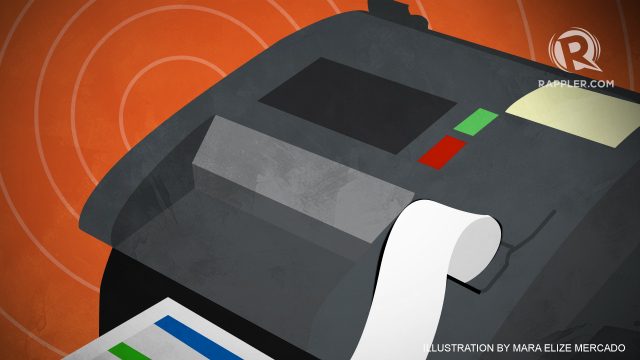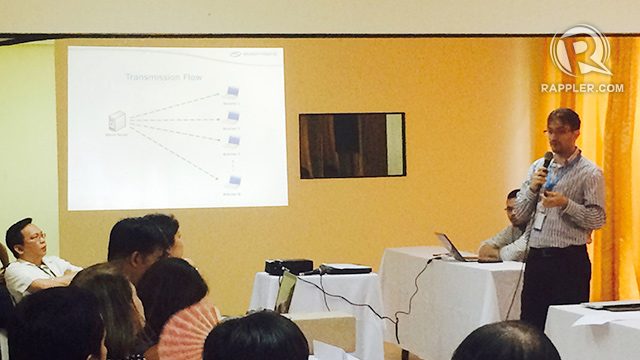SUMMARY
This is AI generated summarization, which may have errors. For context, always refer to the full article.

MANILA, Philippines – Just behind Taguig City Hall is Gen. Ricardo Papa Memorial High School. It’s literally a stone’s throw away from the city’s Commission on Elections (Comelec) office inside the city hall compound.
A teacher who will be chairman of the Board of Election Inspectors (BEI) in that school for the 3rd straight automated election told Rappler that all 7 clustered precincts there had successfully transmitted election returns in the past election.
Curiously, however, the transmissions from Gen. Ricardo Papa Memorial High School did not reach the Comelec Transparency Server, which is supposed to give public access to precinct-level results.
In the 2013 elections, Taguig City was tagged an area of concern because of its failure to transmit more than 50% of results to the Transparency Server. (READ: Taguig poll transmission failure a ‘puzzle’)
All in all, Taguig City had a transmission rate of only 46.95% in 2013, the lowest in Metro Manila, and roughly the same as the transmission rates in some Mindanao provinces, which are thousands of kilometers away from the capital.
Transmission woes in 2013
Another affected school, more than 3 kilometers from Taguig City Hall, is Tipas National High School. It is located deep inside a residential area, with not much signboards leading to it.
In 2013, all 8 clustered precincts in that school were also unable to transmit election returns (ERs), at least to the Transparency Server. (READ: How does the PH automated election system work?)
At the time, signal there was weak, a school department head who served as a poll officer during the May 2013 polls told Rappler. They tried 4 times to transmit the ERs via the then-called precinct count optical scan (PCOS) machines, but to no avail.
In the end, they were accompanied by security to hand-carry the compact flash (CF) cards – containing the digital ERs – to Taguig City Hall. This was to ensure that the votes cast in Tipas National High School were still counted.
Our analysis shows that the percentage of ERs received by the Comelec Transparency Server in 2013 decreased to 76% (59,699 out of 78,193 clustered precincts or CPs), from roughly 90% in 2010 (69,024 out of 76,528 CPs).
Looking at the breakdown of transmission rates to the Transparency Server, almost all provinces had lower rates in 2013 versus those in 2010. It fell the most in some provinces in the Cordillera Administrative Region (CAR) and in the western Mindanao area, including the Autonomous Region in Muslim Mindanao (ARMM).
On the flip side, the biggest improvement was recorded in Apayao, while only 6 other provinces (shaded blue on the map below) likewise reported better transmission rates compared to 2010.
Looking deeper into the data, a total of 76 towns in 24 provinces had a 0% transmission rate. Curiously, this includes Bacoor City in Cavite, just in the outskirts of Metro Manila. According to the data, all 371 clustered precincts there were unable to transmit to the Transparency Server.
Moreover, 4 of 6 towns in Batanes, a whopping 27 towns in Lanao del Sur, 9 towns in Maguindanao, and 6 towns in Sulu also reported a 0% transmission rate.
Transmission rate was likewise 0% in 8,667 out of the 36,855 polling places or voting centers nationwide. This means that none of the ERs in the clustered precincts in those polling places reached the Transparency Server.
Meanwhile, a total of 2,964 polling places had transmission rates of less than 100%.
[Click to show/hide a list of cities and towns with a 0% transmission rate in 2013]
| Province | Towns/Cities with 0% Transmission Rate |
| Abra | Bucloc, Manabo |
| Aurora | Dilasag |
| Basilan | Akbar, Tipo-Tipo, Tuburan |
| Batanes | Ivana, Mahatao, Sabtang, Uyugan |
| Cagayan | Calayan |
| Cavite | Bacoor City |
| Eastern Samar | Jipapad, Maslog |
| Ilocos Norte | Adams |
| Ilocos Sur | Quirino |
| Isabela | Dinapigue, Divilacan, Maconacon, Palanan, Quirino |
| Lanao del Norte | Matungao |
| Lanao del Sur | Bayang, Bubong, Bumbaran, Butig, Calanogas, Ditsaan-Ramain, Ganassi, Kapai, Lumba-Bayabao, Lumbaca-Unayan, Lumbatan, Lumbayanague, Madalum, Madamba, Marogong, Masiu, Mulondo, Pagayawan, Piagapo, Picong, Poona Bayabao, Pualas, Sultan Dumalondong, Tagoloan II, Taraka, Tubaran, Tugaya |
| Maguindanao | Datu Blah T. Sinsuat, Datu Piang, Datu Salibo, Matanog, Paglat, Pandag, Rajah Buayan, Shariff Saydona Mustapha, Sultan sa Barongis |
| Masbate | San Jacinto |
| Mountain Province | Barlig, Natonin |
| Northern Samar | Silvino Lobos |
| Palawan | Kalayaan |
| Samar | Matuguinao |
| Sultan Kudarat | Palimbang |
| Sulu | Indanan, Kalingalan Caluang, Lugus, Luuk, Pangutaran, Parang |
| Surigao del Norte | San Benito |
| Tawi-Tawi | Mapun, Simunul |
| Zamboanga del Norte | Sirawai |
| Zamboanga Sibugay | Diplahan |
In the lookup table below, see if polling places near you have at least one clustered precinct that wasn’t able to transmit to the Transparency Server in 2013 – meaning, all polling places with less than 100% transmission rate are listed here. Type in the name of the town/city or polling place/school on the search bar.
Not included here are the overseas posts that had automated elections in 2013.
Why did it happen?
Weak cellphone signals – especially in remote areas – and “heavy signal traffic” had been blamed for these transmission problems. Telecommunications companies had strongly reacted to these reports, but they have since coordinated with the Comelec to improve the transmission of election returns.
Some procedures on election day had also contributed to the low 2013 transmission rate, said William Yu, an information technology director of the Parish Pastoral Council for Responsible Voting (PPCRV).
Yu said that during the 2010 and 2013 polls, the “manual loading” of untransmitted election results at the city/municipal canvassing centers were in place as a contingency measure. From the canvassing servers where they were loaded, these manually-loaded ERs were then transmitted to the Transparency Server and the Comelec central servers.
Yu noted that in 2013, “that system was also available, but the manually-loaded data, we did not get.” PPCRV was among the groups that had access to Transparency Server data.
He also pointed out that some election inspectors inadvertently “leave out” the transmission to the Transparency Server once the ERs were successfully sent to either the Comelec central server or to the city/municipal canvassing server.
“We have to check also. Just because it has transmitted doesn’t mean it was transmitted to all 3 [servers],” said Yu. This is likely what happened at Gen. Ricardo Papa Memorial High School in Taguig City.
With the Transparency Server being the last one to receive transmissions in 2013, Yu raised the possibility that some BEIs “become impatient, they want to go home already, so they don’t attempt to retransmit” to the Transparency Server anymore.
Reports like these highlight the need to make sure that the transmission of ERs to all servers – including the Transparency Server – are successful, especially for the hotly-contested 2016 presidential elections.

The 2016 challenge
For the 2016 polls, the Comelec targets at least a 90% transmission rate, around the same as in 2010. Poll chief Andres Bautista said that a 100% transmission rate can be possible, but he admitted it might be difficult to achieve, citing factors like the weather, the mere positioning of the vote-counting machine (VCM) inside the polling precinct, and again, poor cellular signals.
To address transmission problems, the Comelec conducted mock elections on February 13 and nationwide transmission readiness tests on April 23.
The poll body boasted of an excellent showing in these tests, but it covered only a few clustered precincts: 40 in the February mock polls, then down to 20 in the April tests.
During the February mock polls, votes were transmitted via Broadband Global Area Network (BGAN) terminals, not through cellular SIMs and mobile data, which will be the case in most precincts on election day. (Stronger but more expensive BGAN terminals will still be deployed, but in only a few areas.)
In a briefing on April 29 with groups that will have access to the Transparency Server, Smartmatic project manager Marlon Garcia said that for 2016, the deployment of transmission media will be increased. Smartmatic is the supplier of the 90,000+ VCMs that will be used on May 9.
There will also be additional contingency measures, Garcia said, such as the “sharing” of BGAN terminals among neighboring polling places.
Comelec Commissioner Christian Robert Lim likewise said that in 2016, “we want all votes to be accounted for.” To achieve this, there will be procedural changes after the polls close on May 9.
Among them, Lim said that the sequence of transmission of votes will be reversed: first to the Transparency Server, then to the Comelec central server, and the servers at the city/municipal board of canvassers (BOC).
Lim also said that all SD cards, “whether transmitted or not, will have to be imported [to the city/municipality canvassing servers] so that they it throw to both the Transparency and Comelec Central Servers.”
However, as per Comelec Resolution No. 10103, the transmission of election results to the provincial canvassing server can only happen “until results from all main SD cards have been imported.”
Would votes be recorded twice due to this redundancy? Lim said that Smartmatic “gave them assurances” that no data will be overwritten. “Once natanggap na at nagbato ulit, hindi na tatanggapin… Ii-ignore na lang ‘yung panibago,” he explained. (Once data has been received from a source and the same data from the same source comes in, it wouldn’t be accepted anymore. It would just be ignored.)
Plus, the ID of the machine that generated the election returns will be logged, along with the IP address of the machine that transmitted the ERs, added Garcia.
“We’re expecting canvassing to take longer on the ground,” Lim said. “We’re creating those redundancies to make sure that all results are being reported.”
The BOCs and election officers will also be authorized to follow up with the BEIs in clustered precincts where the VCMs failed to transmit.
With these developments, PPCRV’s William Yu thinks that the transmission of votes will improve in 2016. “I don’t think we will have the same level of poor transmission quality [as in past polls],” he declared.
In the country’s 3rd automated elections marked by a tight presidential race, anything less than 100% will not be acceptable. – data processed by Wayne Manuel and map created by Russell Shepherd/Rappler.com
Add a comment
How does this make you feel?
There are no comments yet. Add your comment to start the conversation.